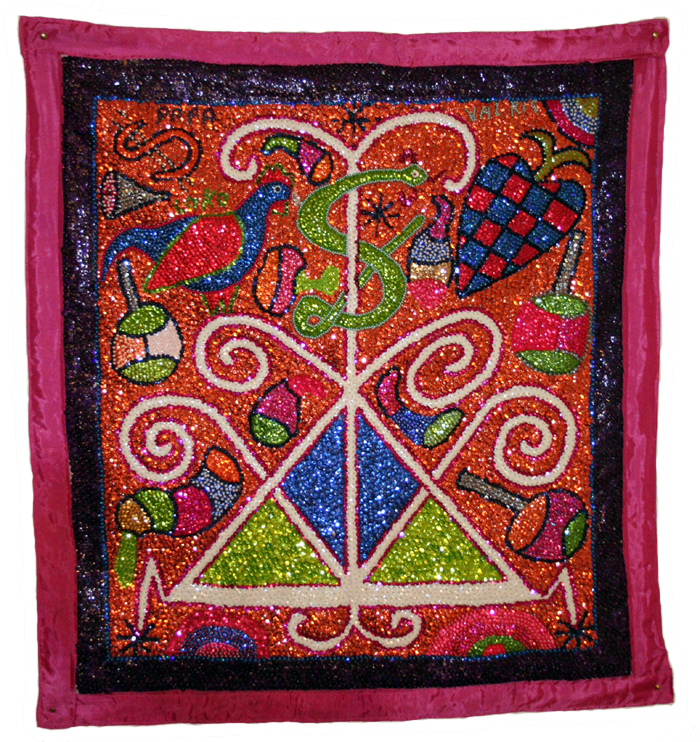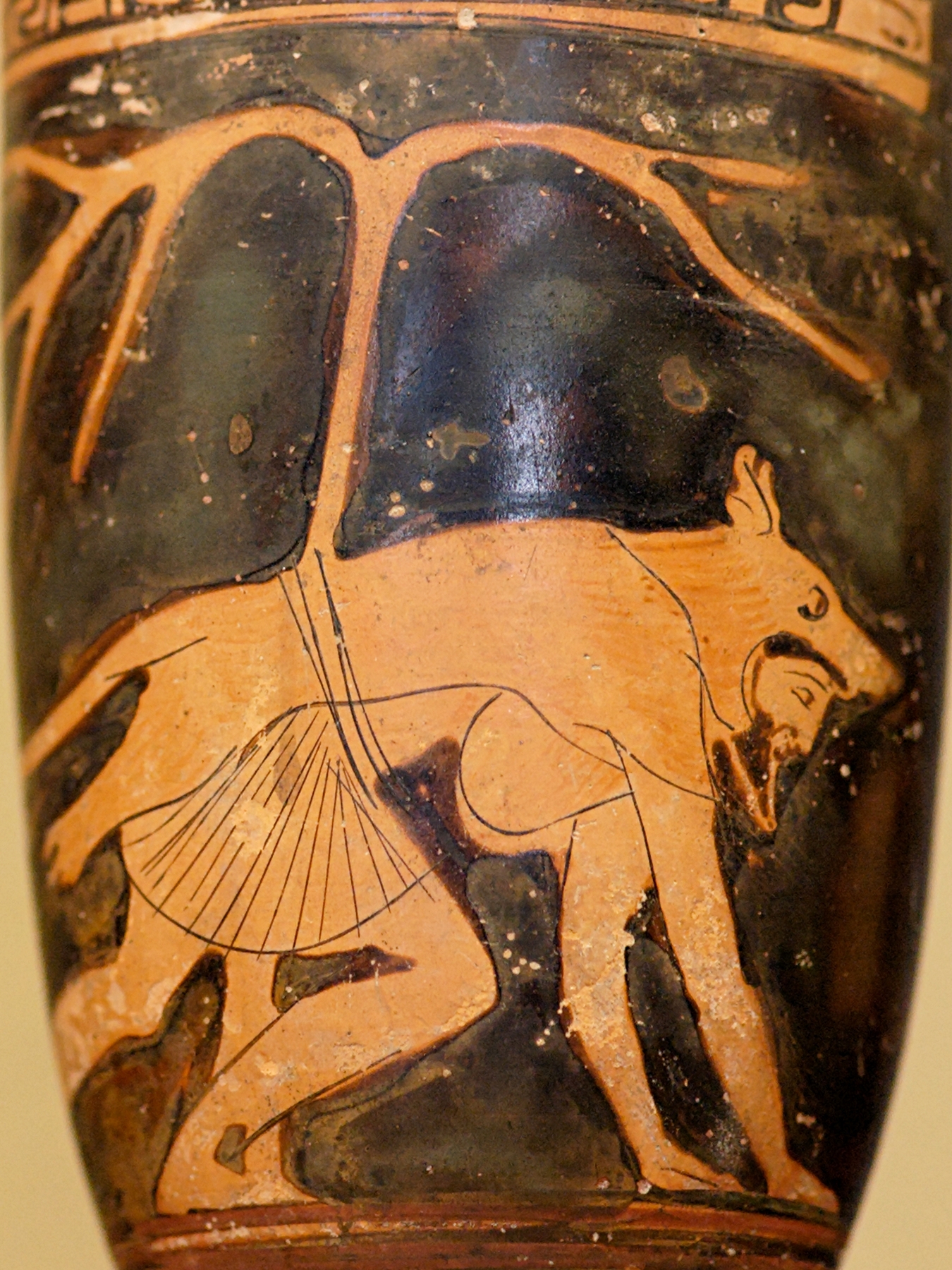|
Haitian Mythology
Haitian mythology consists of many folklore stories from different time periods, involving sacred dance and deities, all the way to Vodou. Haitian Vodou is a syncretic mixture of Roman Catholic rituals developed during the French colonial period, based on traditional African beliefs, with roots in Dahomey, Kongo and Yoruba traditions, and folkloric influence from the indigenous Taino peoples of Haiti. The lwa, or spirits with whom Vodou adherents work and practice, are not gods but servants of the Supreme Creator Bondye (pronounced Bon Dieu). A lot of the Iwa identities come from deities formed in the West African traditional regions, especially the Fon and Yoruba. In keeping with the French-Catholic influence of the faith, Vodou practioneers are for the most part monotheists, believing that the lwa are great and powerful forces in the world with whom humans interact and vice versa, resulting in a symbiotic relationship intended to bring both humans and the lwa back to Bon ... [...More Info...] [...Related Items...] OR: [Wikipedia] [Google] [Baidu] |
Haitian Vodou
Haitian Vodou () is an African diasporic religions, African diasporic religion that developed in Haiti between the 16th and 19th centuries. It arose through a process of syncretism between several traditional religions of West Africa, West and Central Africa and Roman Catholicism. There is no central authority in control of the religion and much diversity exists among practitioners, who are known as Vodouists, Vodouisants, or Serviteurs. Vodou teaches the existence of a transcendent creator divinity, Bondyé, Bondye, under whom are spirits known as . Typically deriving their names and attributes from traditional West and Central African deities, they are equated with Roman Catholic saints. The divide into different groups, the ("nations"), most notably the Rada lwa, Rada and the Petro lwa, Petwo, about whom various myths and stories are told. This theology has been labelled both Monotheism, monotheistic and Polytheism, polytheistic. An initiatory tradition, Vodouists commonly ... [...More Info...] [...Related Items...] OR: [Wikipedia] [Google] [Baidu] |
Traditional Medicine
Traditional medicine (also known as indigenous medicine or folk medicine) refers to the knowledge, skills, and practices rooted in the cultural beliefs of various societies, especially Indigenous groups, used for maintaining health and treating illness. In some Asia, Asian and Africa, African countries, up to 80% of people rely on traditional medicine for primary health care. Traditional medicine includes systems like Ayurveda, traditional Chinese medicine, and Unani medicine, Unani. The World Health Organization supports their integration, but warns of potential risks and calls for more research on their safety and effectiveness. The use of medicinal herbs spans over 5,000 years, beginning with ancient civilizations like the Sumer, Sumerians, Ancient Egypt, Egyptians, Indian people, Indians, and Chinese people, Chinese, evolving through Ancient Greece, Greek, Ancient Rome, Roman, Islam, Islamic, and Middle Ages, medieval European traditions, and continuing into Colonial histo ... [...More Info...] [...Related Items...] OR: [Wikipedia] [Google] [Baidu] |
Adya Houn'tò
Adya Hount'tò is a loa associated with drumming in West African Vodun West is one of the four cardinal directions or points of the compass. It is the opposite direction from east and is the direction in which the Sun sets on the Earth. Etymology The word "west" is a Germanic word passed into some Romance langu .... References * Voodoo gods Arts gods {{Deity-stub Voodoo deities ... [...More Info...] [...Related Items...] OR: [Wikipedia] [Google] [Baidu] |
Adjassou-Linguetor
Adjassou-Linguetor is a loa with protruding eyes and a bad temper in Haitian Vodou Haitian Vodou () is an African diasporic religions, African diasporic religion that developed in Haiti between the 16th and 19th centuries. It arose through a process of syncretism between several traditional religions of West Africa, West and .... She governs spring water. References Haitian Vodou goddesses Sea and river goddesses {{Africa-myth-stub ... [...More Info...] [...Related Items...] OR: [Wikipedia] [Google] [Baidu] |
Zombie
A zombie (Haitian French: ; ; Kikongo: ''zumbi'') is a mythological undead corporeal revenant created through the reanimation of a corpse. In modern popular culture, zombies appear in horror genre works. The term comes from Haitian folklore, in which a ''zombie'' is a dead body reanimated through various methods, most commonly magical practices in religions like Vodou. Modern media depictions of the reanimation of the dead often do not involve magic but rather science fictional methods such as fungi, radiation, gases, diseases, plants, bacteria, viruses, etc. Zombies are real-life individuals in Haiti who have undergone a religious punishment called zombification for committing crimes such as rape or land theft. They are drugged, buried alive, exhumed and then enslaved by secret societies in Haiti. This practice became the basis for the zombie myth of a resurrected corpse. The English word "zombie" was first recorded in 1819 in a history of Brazil by the poet Robert S ... [...More Info...] [...Related Items...] OR: [Wikipedia] [Google] [Baidu] |
Rada Lwa
The Rada are a family of lwa spirits in the religion of Haitian Vodou. They are regarded as being sweet-tempered and "cool", in this contrasting with the Petro lwa, which are regarded as volatile and "hot". Description The Rada lwa have been described as a "pantheon" of deities in Haitian Vodou. The Rada lwa are deemed sweet-natured and dependable. In this, they contrast with the Petwo lwa, whom are deemed volatile and hot-tempered. The Rada are referred to as ''lwa rasin'', meaning "root lwa." As they are often regarded as having an intimate relationship with their worshippers, they are often given names implying a family connection, such as ''Papa'' ("father") and ''Kouzen'' ("cousin"). The Petwo lwa are kept separate from the Rada lwa, both spatially, by placing their altars in different parts of the ''ounfo'' (temple), and temporally, by invoking them at different stages in a ritual. History The Rada pantheon have West African origins; specifically, the pantheon of Rada lwa ... [...More Info...] [...Related Items...] OR: [Wikipedia] [Google] [Baidu] |
Petro Lwa
The Petwo (), also spelled Petro and alternatively known as , are a family of lwa (loa) spirits in the religion of Haitian Vodou. They are regarded as being volatile and "hot", in this contrasting with the Rada lwa, which are regarded as sweet-tempered and "cool." Description The Petwo are also known as the Dompete. They are considered one of the ('nations') of lwa spirits in the religion. Various commentators have described the Petwo as a "pantheon" of deities. Along with the Rada, they are one of the two main groups of lwa worshipped by practitioners in Port-au-Prince. The Petwo spirits are considered to be volatile and hot-tempered, exhibiting bitter, aggressive, and forceful characteristics. In this they contrast with the Rada lwa, who are deemed sweet-natured and dependable. The Petwo lwa are kept separate from the Rada lwa, both spatially, by placing their altars in different parts of the (temple), and temporally, by invoking them at different stages in a ritual. The ant ... [...More Info...] [...Related Items...] OR: [Wikipedia] [Google] [Baidu] |
Fish
A fish (: fish or fishes) is an aquatic animal, aquatic, Anamniotes, anamniotic, gill-bearing vertebrate animal with swimming fish fin, fins and craniate, a hard skull, but lacking limb (anatomy), limbs with digit (anatomy), digits. Fish can be grouped into the more basal (phylogenetics), basal jawless fish and the more common jawed fish, the latter including all extant taxon, living cartilaginous fish, cartilaginous and bony fish, as well as the extinct placoderms and acanthodians. In a break to the long tradition of grouping all fish into a single Class (biology), class (Pisces), modern phylogenetics views fish as a paraphyletic group. Most fish are ectotherm, cold-blooded, their body temperature varying with the surrounding water, though some large nekton, active swimmers like white shark and tuna can hold a higher core temperature. Many fish can communication in aquatic animals#Acoustic, communicate acoustically with each other, such as during courtship displays. The stud ... [...More Info...] [...Related Items...] OR: [Wikipedia] [Google] [Baidu] |
Mermaid
In folklore, a mermaid is an aquatic creature with the head and upper body of a female human and the tail of a fish. Mermaids appear in the folklore of many cultures worldwide, including Europe, Latin America, Asia, and Africa. Mermaids are sometimes associated with perilous events such as storms, shipwrecks, and drownings (cf. ). In other folk traditions (or sometimes within the same traditions), they can be benevolent or beneficent, bestowing boons or falling in love with humans. The male equivalent of the mermaid is the merman, also a familiar figure in folklore and heraldry. Although traditions about and reported sightings of mermen are less common than those of mermaids, they are in folklore generally assumed to co-exist with their female counterparts. The male and the female collectively are sometimes referred to as merfolk or merpeople. The Western concept of mermaids as beautiful, seductive singers may have been influenced by the sirens of Greek mythology, which w ... [...More Info...] [...Related Items...] OR: [Wikipedia] [Google] [Baidu] |
Sack Man
The Sack Man (also called the Bag Man or Man with the Bag/Sack) is a figure similar to the bogeyman, portrayed as a man with a sack on his back who carries naughty children away. Regional traditions Variants of this figure appear all over the world, particularly in America, where it is referred to as , , or in Portuguese, (all of which mean "the sack/bag man"), and Eastern Europe. Similar legends are found in Haiti and some countries in Asia. Iberia and Latin America In Spain, is usually depicted as a mean and impossibly ugly and skinny old man who eats the misbehaving children he collects. The crime of Gádor gave rise to this term because the kidnappers used a gunny sack to carry with the children. In Brazil, is portrayed as a tall and imposing adult male, usually in the form of a vagrant, who carries a sack on his back, and collects mean disobedient children for nefarious purposes. In Chile, Argentina, and particularly in the Southern and Austral Zones, is mostly ... [...More Info...] [...Related Items...] OR: [Wikipedia] [Google] [Baidu] |
Werewolf
In folklore, a werewolf (), or occasionally lycanthrope (from Ancient Greek ), is an individual who can shapeshifting, shapeshift into a wolf, or especially in modern film, a Shapeshifting, therianthropic Hybrid beasts in folklore, hybrid wolf–humanlike creature, either purposely or after being placed under a curse or affliction, often a bite or the occasional scratch from another werewolf, with the transformations occurring on the night of a full moon. Early sources for belief in this ability or affliction, called lycanthropy, are Petronius (27–66) and Gervase of Tilbury (1150–1228). The werewolf is a widespread concept in European folklore, existing in many variants, which are related by a common development of a Christianization, Christian interpretation of underlying European folklore developed during the Middle Ages. From the early modern period, werewolf beliefs spread to the New World with colonialism. Belief in werewolves developed in parallel to the belief in Eu ... [...More Info...] [...Related Items...] OR: [Wikipedia] [Google] [Baidu] |
Ti Malice And Bouki
Ti Malice is a trickster character and nemesis of Tonton (Uncle) Bouki in Haitian folklore. While Ti Malice is smart and guileful, Uncle Bouki is hardworking but is also very greedy. It is the manipulation of this greed that allows Ti Malice to often get the best of Uncle Bouki. These characters are said to be a split of Anansi, the trickster character of the Ashanti of Ghana. Bouki and Malice have their origins in African oral traditions. In Senegal and neighbouring countries, these two characters appear in animal form. Bouki is represented as a hyena, which is called "Bouki" in the Fulani and Wolof languages, while Malice is a hare Hares and jackrabbits are mammals belonging to the genus ''Lepus''. They are herbivores and live Solitary animal, solitarily or in pairs. They nest in slight depressions called forms, and their young are precociality, able to fend for themselves ... called "Leuk" in Senegal. From there, character traits develop that identify the two companions. ... [...More Info...] [...Related Items...] OR: [Wikipedia] [Google] [Baidu] |







